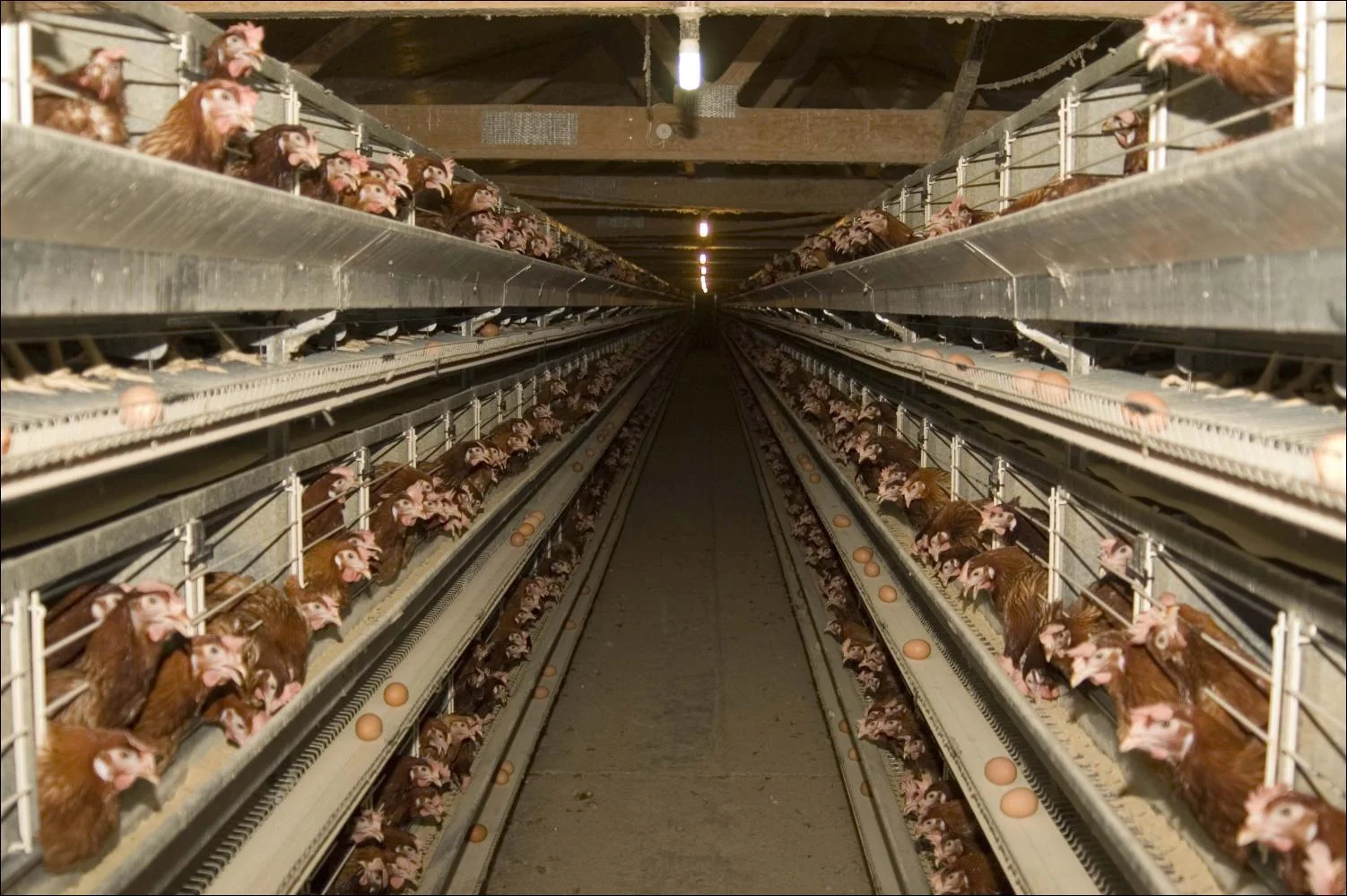Humans have been essential in creating the modern-day, egg-laying hen.
Humans have not only domesticated hens, but actively reshaped their biology. Our desire for eggs has driven a complete transformation of the modern hen, forcing her into an unnatural, relentless cycle of laying. Our anthropocentric justifications for using domesticated fowl throughout history have shaped their evolution in ways that would never have occurred naturally.
In other words, humans have acted—and continue to act—as an artificial agent for natural selection, pushing hens far beyond their natural reproductive limits *1. Unlike natural selection, which favors traits for survival, human-driven selection prioritizes profit and output, often at the expense of the hen’s well-being *2. Today, genetic hybridization dominates the industry, with modern hens bred specifically for extreme productivity *3. This is not evolution—it’s engineering.
The Origins of Domesticated Chickens
The domesticated hen traces her roots to the red junglefowl (Gallus gallus), a wild species native to Southeast Asia *4. Unlike today’s hens, junglefowl lay only 10–15 eggs per year, seasonally, for reproduction *5. Over thousands of years, humans selectively bred hens for increased egg production.
Fowl spread westward through trade, conquest, and colonization, reaching India, Africa, and eventually Europe *6. Initially, they were used for cockfighting, meat, and religious sacrifice, with egg production being a secondary consideration *7. However, early farmers noticed that taking eggs from a nest could sometimes trigger hens to lay more eggs beyond their natural cycle. This unintentional manipulation marked the first steps toward breeding hens for constant egg production *8.
Archaeological evidence suggests that breeding hens to encourage year-round laying may have begun 5,000–10,000 years ago *9. However, egg-laying as an independent activity, detached from reproduction, is entirely unnatural *10. Despite this, modern hens have been forced to lay almost one egg per day for over a year before their bodies give out *11.
Early Mass Production: The First Steps Toward Factory Farming
The Egyptians were the first civilization to develop large-scale egg production systems, hatching chicks in heated brick ovens as early as 1400 BCE *12—a method strikingly similar to today’s industrial hatcheries. The Romans later introduced specialized chicken farms, incorporating henhouses and confinement systems to increase efficiency *13.
By the Middle Ages, poultry farming had spread across Europe, but hens still laid relatively few eggs—about 30–50 per year on average *14. Selective breeding intensified during this period, but egg production did not significantly increase until the 19th and 20th centuries *15.
The 20th Century: From Farmyard to Factory
At the start of the 20th century, hens still lived relatively free lives on small farms, laying at most 80–150 eggs per year *16. However, the poultry industry saw an opportunity to maximize profits by manipulating egg production through:
Selective breeding to increase egg output *17
Controlled lighting to trick hens into laying year-round *18
Nutritional modifications to stimulate continuous laying *19
By the 1920s, poultry competitions encouraged farmers to breed hens that laid the most eggs. One breed, the Australorp, famously laid 364 eggs in 365 days in an Australian egg-laying trial, proving extreme productivity was possible *20.
The 1930s and 40s saw the emergence of scientific breeding programs, where universities and research facilities genetically selected hens for year-round egg production *21.
By the 1950s, hens were laying over 200 eggs per year, and the push for higher yields continued *22.
Such imagery recalls a more idyllic and simpler time.
The Modern Hen: Engineered for Exploitation
Today’s commercial egg-laying hen is a product of relentless genetic manipulation. She is no longer a junglefowl—her body has been entirely reshaped to serve human demand *23.
Hens were among the first farmed animals to be permanently confined indoors in large numbers, housed in automated systems based on intensive genetic selection for extreme productivity *24. The poultry industry in the United States became the global model for animal agriculture, accelerating the mass exploitation of birds worldwide *25. The modern hen is one of the most genetically altered animals on the planet, her body pushed to unnatural limits in a cycle of exhaustion, disease, and premature slaughter *26.
Post World War II poultry processing facility.
Modern hens lay between 250–330 eggs per year, a staggering increase from their wild ancestors, who laid only 10–15 eggs annually for reproduction *27. Some strains, such as Hy-Line Brown and Lohmann, are now selectively bred to lay up to 500 eggs in a single cycle—a level of production biologically impossible without human intervention *28.
Unlike chickens in the meat industry, which are bred for rapid muscle growth and slaughtered at just 6 weeks old, hens in the egg industry are pushed into prolonged exhaustion before being killed at 72–100 weeks *29. By this time, their bodies are depleted from continuous ovulation, leaving them prone to ovarian cancer, osteoporosis, fractures, reproductive disorders, and premature death *30.
Despite marketing labels that suggest otherwise, all egg production—whether free-range, organic, or conventional—relies on hens bred for hyperovulation *31. These birds do not lay because it is natural; they lay because they have been engineered to do so *32.
Egg production is not a natural process—it is the result of deliberate and extreme human intervention. From the wild junglefowl laying a handful of eggs per year to today’s hens laying nearly every day, the stark reality is clear: this is not nature. This is exploitation *33.
To learn more about modern day farming practices and the life cycle of an egg laying hen, please go to: Life of A Hen
-
PMC: Contrafreeloading and Foraging Behavior in Hens
PMC: Reallocation of Resources Toward Reproduction
ScienceDirect: Egg Quality & Productivity Review
United Egg Producers: History of Egg Production
American Heritage: The Chicken Story
RSPCA Knowledgebase: Origin of Domesticated Chickens
Australorp - Wikipedia
Livestock Extension Wisconsin: Chicken Domestication
ScienceDirect: Hen Genetic Selection for Laying Persistency
PMC: Historical Overview of Poultry in Japan
RSPCA Knowledgebase: Layer Hen Lifespan in Commercial Farming
American Heritage: Chicken Farming in Ancient Egypt
The Poultry Site: Egg Industry Genetic Selection Trends
Livestock Extension Wisconsin: Pre-Industrial Poultry Farming
Smithsonian Magazine: History of Chicken Domestication
RSPCA Assured: Egg-Laying Hen Welfare Standards
United Egg Producers: Egg-Laying Trends in the U.S.
Poultry Science Journal: Impact of Artificial Lighting on Laying Hens
Lohmann Breeders: Feeding Laying Hens to 100 Weeks of Age
Australorp Egg-Laying Record - Wikipedia
PMC: Evolution of Poultry Industry Post-WWII
The Poultry Site: Reaching the Goal of 500 Eggs Per Hen
ScienceDirect: Chicken Domestication and Selection Pressures
United Egg Producers: Advances in Hen Productivity
PMC: Broiler vs. Layer Hen Genetic Modifications
Lohmann Breeders: Egg Quality and Laying Persistency
RSPCA: How Are Layer Hens Farmed?
Pancosma: Persistency in Lay – Achieving 500 Eggs in 100 Weeks
PMC: Long-Term Health Issues in Laying Hens
RSPCA: The Short Lives of Laying Hens
Poultry Science: The Role of Genetics in Egg Production
American Heritage: The Transformation of Poultry Farming
Lohmann Breeders: The Global Push for Longer Laying Cycles


